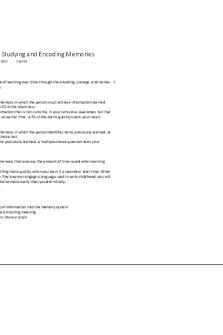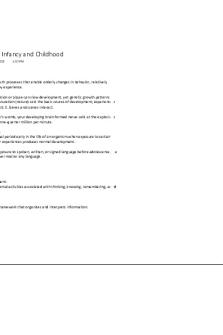Module 22 - Kristy Huntley - Introduction to Psychology : PSYC 1111 Textbook: Myers and PDF

| Title | Module 22 - Kristy Huntley - Introduction to Psychology : PSYC 1111 Textbook: Myers and |
|---|---|
| Author | Scott Bauman |
| Course | Introduction To Psychology |
| Institution | University of New Haven |
| Pages | 6 |
| File Size | 201.1 KB |
| File Type | |
| Total Downloads | 13 |
| Total Views | 152 |
Summary
Kristy Huntley - Introduction to Psychology : PSYC 1111
Textbook: Myers and DeWall, Exploring Psychology 10e in Modules
-----
Module 22 - Textbook Notes...
Description
Module 22 : Studying and Encoding Memories Monday, September 30, 2019
7:56 PM
Memory: - The persistence of learning over time through the encoding, storage, and retrieva al of information. Recall: - A measure of memory in which the person must retrieve information learned earlier, as on a fill-in-the-blank test. - Retrieving information that is not currently in your conscious awareness but that was learned at an earlier time. A fill-in-the-blank question tests your recall. Recognition: - A measure of memory in which the person identifies items previously learned, as on a multiple-choice test. - Identifying items previously learned. A multiple-choice question tests your recognition. Relearning: - A measure of memory that assesses the amount of time saved when learning material again. - Learning something more quickly when you learn it a second or later time. When you study for a final exam or engage a language used in early childhood, you will relearn the material more easily than you did initially. ~ Memory Models ~ -Encoding: - The processing of information into the memory system - For example: by extracting meaning. - Get information into our brain
Storage: - The process of retaining encoded information over time. - Retain that information Retrieval: - The process of getting information out of memory storage. - Later get the information back out. Parallel Processing: - The processing of many aspects of a problem simultaneously; the brain's natural mode of information processing for many functions. Connectionism: - Views memories as products of interconnected neural networks. - Every time you learn something new, your brain’s neural connections change, forming and strengthening pathways that allow you to interact with and learn from your constantly changing environment. Richard Atkinson and Richard Shiffrin (1968): 1) Sensory Memory: - The immediate, very brief recording of sensory information in the memory syste m. - We first record to-be-remembered information as a fleeting sensory memory. 2) Short-term Memory: - Activated memory that holds a few items briefly, such as the seven digits of a phone number while calling, before the information is stored or forgotten. - From there, we process information into short-term memory, where we encode t through rehearsal. 3) Long-term Memory: - The relatively permanent and limitless storehouse of the memory system. Include es knowledge, skills, and experiences. - Finally, information moves into long-term memory for later retrieval.
A modified three-stage processing model of memory Atkinson and Shiffrin’s classic three-step model helps us to think about how memories are processed, but today’s researchers recognize other ways long-term memories form. For example, som e information slips into long-term memory via a “back door,” without our consciously attending to it (automatic processing). And so much active processing occurs in the shortterm memory stage that many now prefer the term working memory. ------Working Memory: - A newer understanding of short-term memory that adds conscious, active processing of incoming auditory and visual-spatial information, and of informatio n retrieved from long-term memory.
Working memory Alan Baddeley’s (2002) model of working memory, simplified here,
includes visual and auditory rehearsal of new information. A hypothetical central (manager) focuses attention and pulls information from long-term memory to help make sense of new information.
executive
-----~ Encoding Memories: --
Explicit Memory: - Memory of facts and experiences that one can consciously know and "declare." (Also called declarative memory.) Effortful Processing: - Encoding that requires attention and conscious effort. Automatic Processing: - Unconscious encoding of incidental information, such as space, time, and frequency, and of well-learned information, such as word meanings. Implicit Memories: - Retention of learned skills or classically conditioned associations independent of conscious recollection. (Also called nondeclarative memory.) ~`Automatic Processing and Implicit Memories: - Implicit memories include procedural memory for automatic skills (riding a bike) and classically conditioned associations among stimuli. - Without conscious effort you also automatically process information about: ○ Space: § While studying, you often encode the place on a page where certain material appears; later, when you want to retrieve the information, yo ou may visualize its location on the page. ○ Time: § While going about your day, you unintentionally note the sequence of f its events. Later, realizing you’ve left your coat somewhere, the event sequence your brain automatically encoded will enable you to retrace your steps. ○ Frequency: § You effortlessly keep track of how many times things happen, as when n you realize, This is the third time I’ve run into her today. ~`Effortful Processing and Explicit Memories: - Automatic processing happens effortlessly.
Iconic Memory: - A momentary sensory memory of visual stimuli; a photographic or picture-image memory lasting no more than a few tenths of a second. Echoic Memory: - A momentary sensory memory of auditory stimuli; if attention is elsewhere, sounds and words can still be recalled within 3 or 4 seconds. ~`Effortful Processing Strategies: Chunking: - Organizing items into familiar, manageable units; often occur automatically. (Acronyms) [ROYGBIV, HOMES] Mnemonics: - Memory aids, especially those techniques that use vivid imagery and organizational devices. ***When combined, chunking and mnemonic techniques can be great memory aids fo r unfamiliar material.*** Spacing Effect: - The tendency for distributed study or practice to yield better long-term retention n than is achieved through massed study or practice. Distributive practice produces better long-term recall. Testing Effect: - Enhanced memory after retrieving, rather than simply rereading information. Als o referred to as a retrieval practice effect or test-enhanced learning. Spaced study and self-assessment beat cramming and rereading. Practice may not mak e perfect, but smart practice—occasional rehearsal with self-testing—makes for lasting memories.
Shallow Processing: - Encoding on a basic level based on the structure or appearance of words. Deep Processing: - Encoding semantically, based on the meaning of the words; tends to yield the bes st retention. The amount remembered depends both on the time spent learning and on your makin g it meaningful for deep processing....
Similar Free PDFs

PSYC 1111 - Journal 2
- 2 Pages

Final-Exam PSYC1111 - psyc 1111
- 11 Pages

introduction to psychology
- 70 Pages

introduction to psychology
- 39 Pages

Introduction to Psychology
- 46 Pages

An introduction to Psychology
- 4 Pages

Myers Psychology Vocab
- 17 Pages

Introduction TO Psychology
- 10 Pages

Introduction to Psychology Notes
- 29 Pages
Popular Institutions
- Tinajero National High School - Annex
- Politeknik Caltex Riau
- Yokohama City University
- SGT University
- University of Al-Qadisiyah
- Divine Word College of Vigan
- Techniek College Rotterdam
- Universidade de Santiago
- Universiti Teknologi MARA Cawangan Johor Kampus Pasir Gudang
- Poltekkes Kemenkes Yogyakarta
- Baguio City National High School
- Colegio san marcos
- preparatoria uno
- Centro de Bachillerato Tecnológico Industrial y de Servicios No. 107
- Dalian Maritime University
- Quang Trung Secondary School
- Colegio Tecnológico en Informática
- Corporación Regional de Educación Superior
- Grupo CEDVA
- Dar Al Uloom University
- Centro de Estudios Preuniversitarios de la Universidad Nacional de Ingeniería
- 上智大学
- Aakash International School, Nuna Majara
- San Felipe Neri Catholic School
- Kang Chiao International School - New Taipei City
- Misamis Occidental National High School
- Institución Educativa Escuela Normal Juan Ladrilleros
- Kolehiyo ng Pantukan
- Batanes State College
- Instituto Continental
- Sekolah Menengah Kejuruan Kesehatan Kaltara (Tarakan)
- Colegio de La Inmaculada Concepcion - Cebu






